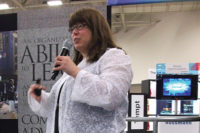EDITOR’S NOTE: The following is excerpted from Case Study: Transcritical Carbon Dioxide Supermarket Refrigeration Systems, which was prepared by Navigant Consulting Inc. for the Better Buildings Alliance, Building Technologies Office, Office of Energy Efficiency and Renewable Energy, U.S. Department of Energy.
The DOE Better Buildings Alliance Refrigeration Team partnered with Hannaford Supermarkets over a period of one year to study the operation of Hannaford’s store in Turner, Maine, which features a transcritical carbon dioxide refrigeration system. This store was the first in the United States to utilize the technology. Compared to a nearly-identical store in the same climate zone using a traditional HFC system, the CO2 store showed a storewide reduction in climate impact of 15 percent over the study period while maintaining a similar energy use profile and the necessary levels of temperature control and reliability.
To read the entire study, go to http://energy.gov/eere/buildings/downloads/case-study-transcritical-carbon-dioxide-supermarket-refrigeration-systems.
This case study documents one year of operating experience with a transcritical carbon dioxide (TC CO2) booster refrigeration system at Delhaize America’s Hannaford supermarket location in Turner, Maine. This supermarket, which began operation in June 2013, is the first supermarket installation in the U.S. of a TC CO2 booster refrigeration system. We compare refrigeration system performance to that for a supermarket having nearly identical layout and refrigeration loads, in a similar climate and of similar vintage, that uses a conventional hydrofluorocarbon (HFC) refrigerant. Delhaize provided the submetered and utility data used to generate the performance summaries herein.
Refrigeration systems account for up to 50 percent of the total electricity consumption of a typical U.S. supermarket. Currently, the majority of supermarket refrigeration systems use hydrofluorocarbon (HFC) refrigerants as a working fluid. HFCs tend to have high global warming potential (GWP) values (in the range of approximately 2,000-4,000) compared to natural refrigerants, most of which have GWPs of 3 or less. Due to international, federal, and local regulations, HFC use may place a significant reporting burden on supermarkets.
One alternative, HFC-free system architecture that is gaining popularity in the global market is the TC CO2 booster refrigeration system. TC CO2 booster systems utilize carbon dioxide as the sole working fluid, unlike carbon dioxide cascade systems seen more commonly in the United States, which still rely on a significant HFC charge. TC CO2 booster systems first gained a major foothold in the European market.
In addition to the lower direct environmental impact (and fewer regulatory requirements) of using a single, non-toxic, low-GWP refrigerant (GWP = 1), other market factors — such as the fluctuating cost of HFC refrigerants — have motivated the uptake of these refrigeration systems in Europe, Australia, and Japan. Implementation of this technology is best suited to a new construction or major retrofit application, as stores with existing HFC or cascade systems will be able to reuse few, if any, existing components.
Energy Consumption
In a comparison of electricity consumption of the refrigeration systems of the two stores on a monthly basis from October 2013 to August 2014, the TC CO2 system’s electricity consumption was of a comparable magnitude to that for the conventional refrigeration system. Overall source energy consumptions (electricity and propane) for the two supermarkets are also comparable.
The substantially lower GWP of carbon dioxide (a value of 1, as opposed to 2,107 for HFC- 407A) means that a TC CO2 system will dramatically reduce the direct environmental impact of refrigeration leakage, recharge, and disposal. In comparing the estimated direct and indirect climate impacts of the two supermarkets, the Turner supermarket reduces climate impacts by about 15 percent. Virtually all of the difference is associated with direct impacts (i.e., refrigerant leakage, recharge, and disposal). The Bradford supermarket achieved a refrigerant leakage rate (191 lb. per year, or about 10 percent of system charge) that is much lower than the typical U.S. supermarket (about 15 percent per year). Therefore, reductions in overall climate impacts will likely be greater when TC CO2 booster systems are compared to typical supermarkets
This new technology carries a significant initial cost premium. Hannaford estimates that the incremental cost of the TC CO2 system (over a prototypical brand-standard HFC system) is about 40 percent for the refrigeration equipment alone, in addition to a 10-15 percent incremental cost for piping and display cases. However, the data suggest that operating costs for the TC CO2 system at Turner are lower compared to the standard HFC system at Bradford because the cost of the refrigerant is lower (roughly one-fourth the cost of the legacy HFC refrigerant).
Additionally, during the study period, the maintenance costs (contracted services, refrigerant purchases, and in-house technician labor) for the Turner refrigeration system were on par with Hannaford’s chain average.
During the study period, the utility and reliability of the Turner TC CO2 booster refrigeration system were comparable to the Bradford HFC system.
Overall Climate, Energy, and Cost Impact
The main sources of environmental impact of the two supermarkets are refrigerant leakage (direct impact) and propane and electricity usage (indirect impact). Chain-wide, Hannaford supermarkets average a leakage rate of about 15 percent annually — below the EPA national average leak rate estimate of 20 percent. For the two supermarkets considered for this case study, measured annual refrigerant leakage was equal: 200 lb. of refrigerant per store over the year-long analysis period. Though the leakage masses are identical, their impact varies tremendously, due to the substantially higher GWP of HFC-407A.
Indirect environmental impact was calculated from propane and electricity bills at both supermarkets over the course of the year using the publicly available EPA Climate Impact Calculator.
The leakage of HFC refrigerant — even in a supermarket such as the one in Bradford where the leakage rates are relatively low — accounts for a significant amount of the total environmental impact (approximately 16 percent of the whole-store climate impact).
Looking solely at the refrigeration system itself, the direct leakage of refrigerant at Bradford constituted about a third of the total impact of the refrigeration system. This is in line with the breakdown of impacts shown in past analytical studies of supermarket refrigeration life-cycle performance.
For the system in Turner, as carbon dioxide has a GWP of only 1, the direct impact is almost negligible. On a full-store basis, the study data indicates that the Turner store exhibited a 15 percent reduction in overall climate impact compared to the baseline store in Bradford. Additionally, the direct impact of the Bradford system is already lower than that of many U.S. supermarkets, which have higher leak rates and utilize refrigerants such as HFC-404A and HFC-507A that have GWP values almost twice that of the HFC-407A used at Bradford.
Lessons Learned
Based on the data procured from installing the booster refrigeration system and operating it for a period of about 13 months, Hannaford and DOE experienced the following lessons learned, which could be useful areas of focus for future adopters of TC CO2 technology.
• System Installation and Commissioning:TC CO2 booster systems require that special attention be paid during system commissioning. Most importantly, as these systems operate at higher pressures, it is crucial that they are pressure tested more carefully upon installation to ensure they are sound; specifically, the pressure relief lines and valves need to be verified.
As during the commissioning of any refrigeration system, the requirements of ASHRAE Standards 15 and 34 need to be reviewed with attention paid to the setup of monitoring and alarming in confined spaces.
Even though carbon dioxide is non-toxic per ASHRAE classifications, it can still pool and displace air, and operators must take the necessary precautions to protect against asphyxiation in the case of a refrigerant leak.
The Turner project featured a unique hot-gas defrost system that required special care in the startup and commissioning due to limited filtration before the electronic expansion valves. This could be an area of concern where a TC CO2 system was being implemented in a retrofit or remodel. Additionally, the plastic electronic expansion valves used in the initial installation also had to be replaced by metal ones within a year of commencing operations due to durability issues.
• Operator Training: The new control system installed in the Turner store — needed for the TC CO2 booster system — also allowed store operators to more easily override lighting schedules and other similar controls as compared to standard store formats. Thus, some deviations from ideal operation may have occurred due to operator unfamiliarity with the new configuration.
Retailers who install a TC CO2 refrigeration system will benefit from noting how the control system differs from those used at other stores, and providing ample guidance and staff training as needed.
• Servicing: Many potential adopters of TC CO2 booster refrigeration systems are concerned with the lack of easily available components and replacement parts. To address this concern, Hannaford required the supplier to preemptively make parts available. An inventory of spares (a parts cabinet) was set up on site, and whenever a part was used, a replacement was procured. This alleviated concerns about unavailable or difficult-to-find replacement parts, as the parts were always on site before they were needed.
Hannaford found this to be a convenient arrangement for this pilot, and strongly recommends keeping a sustained relationship with the supplier during a pilot project such as this, leveraging their resources and learning from their experience.
Pilot projects can be great learning experiences — as more supermarkets invest in pilot installations of TC CO2 refrigeration systems, the industry will likely become more aware and accepting of this technology option. Operators can utilize pilots to adapt new technologies to fit the nuances of their specific business models and brands.










